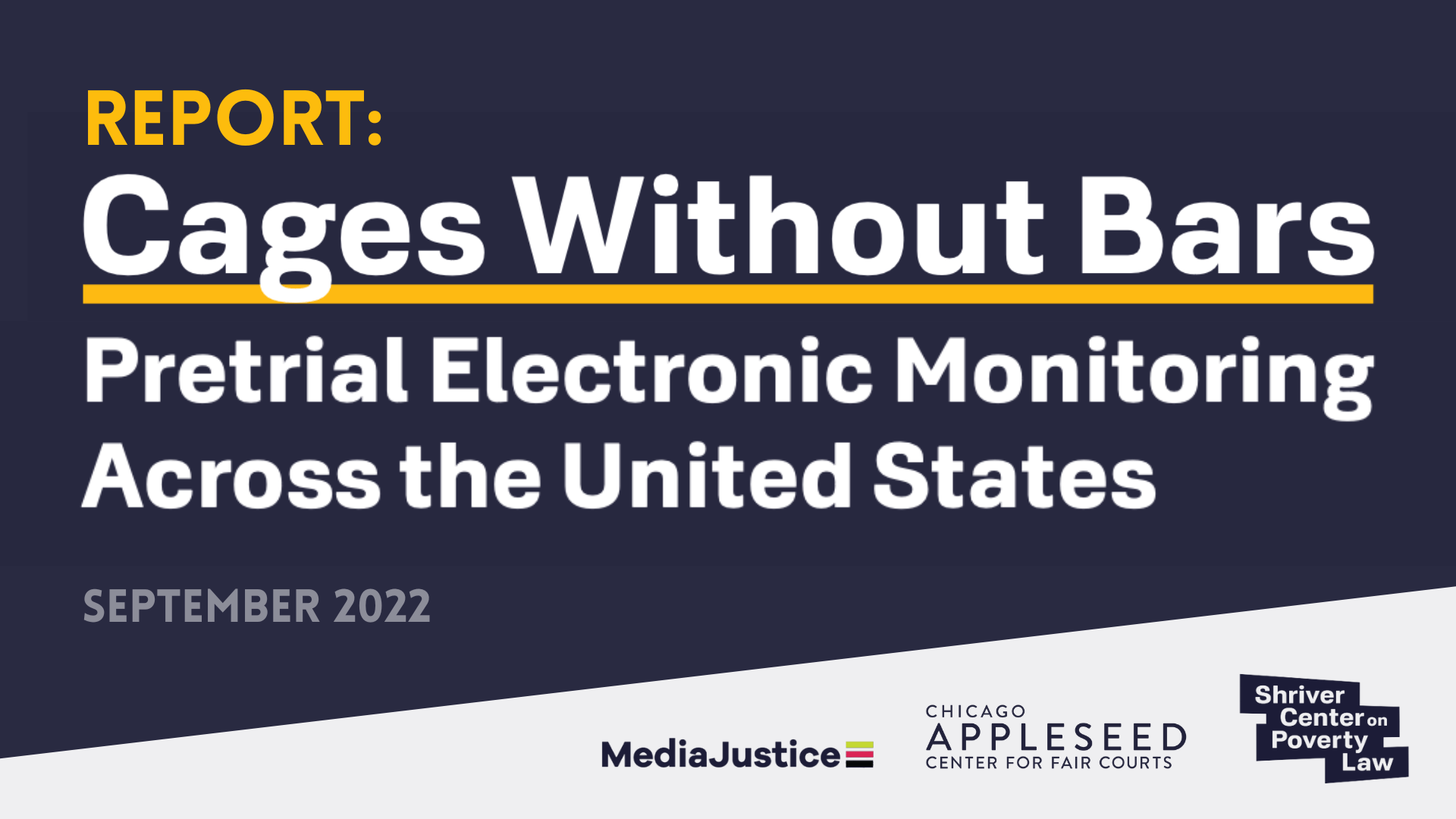REPORT: Cages Without Bars – Pretrial Electronic Monitoring Across the United States
The Shriver Center for Poverty Law, Chicago Appleseed Center for Fair Courts, and MediaJustice have released our report Cages Without Bars: Pretrial Electronic Monitoring Across the United States. This report, which was created with support from the John D. and Catherine T. MacArthur Foundation as part of the Safety and Justice Challenge, is among the first to study the issue of pretrial electronic monitoring as it occurs in multiple jurisdictions.
The report looks at pretrial electronic monitoring (EM) programs in nine jurisdictions across the United States: Cook County, Illinois; Bernalillo County, New Mexico (Albuquerque); the State of Connecticut; Multnomah County, Oregon (Portland); Orleans Parish, Louisiana (New Orleans); Los Angeles County, California; the city and county of San Francisco, California; Baltimore City, Maryland; and Franklin County, Ohio (Columbus). Our researchers conducted interviews with stakeholders in each jurisdiction to learn more about their pretrial electronic monitoring programs and how they function and also interviewed individuals who had spent time on electronic monitoring to learn how being on electronic monitoring had impacted their lives.
Similarly to findings from Chicago Appleseed Center for Fair Courts’ other reports on pretrial electronic monitoring—10 Facts about Pretrial Electronic Monitoring in Cook County (September 2021) and Cook County Electronic Monitoring Review Final Report (September 2022)—Cages Without Bars shows that:
- Pretrial electronic monitoring causes people immense harm. Both through interviews with monitored people and through stakeholder conversations, the authors found that electronic monitoring interfered with individuals’ housing, employment, families, and health.
- Programs vary substantially in their structure and size. Programs ranged from a few dozen monitored people to several thousand, and monitoring levels ranged from pure movement tracking without movement restrictions to full house arrest programs with no ability to leave the home without express approval. There were, however, commonalities – all programs held the threat of incarceration for technical violations of their programs over the heads of monitored individuals.
- Criteria for admission to electronic monitoring programs are unclear. Jurisdictions lacked clear standards and practices to determine who would be placed on electronic monitoring, leaving the decision mostly in the hands of judges. Some counties used electronic monitoring primarily for people with low-level charges, while others used it primarily for people with more serious charges.
- Program administration lacks transparency. Almost none of the jurisdictions were able to provide clear information about basic questions about their EM programs, such as the demographics of the program or how many people were sent back to jail for rule violations. Cook County has two pretrial electronic monitoring programs, one run by the Cook County Sheriff’s Office (CCSO) and the other run by the Office of the Chief Judge (OCJ), The report found that the CCSO’s electronic monitoring program was a notable exception that provided extensive data to researchers, but the OCJ program shared the transparency failings of other jurisdictions.
- Program rules limit people’s freedom. Across all jurisdictions, strict rules and requirements substantially impacted monitored people’s lives, with burdens placed on them by the rules they are required to follow and by the devices themselves, which often prove faulty, showing that people were outside their homes or trying to tamper with the devices when in fact they were not. In many jurisdictions, monitored people were required to pay for the cost of electronic monitoring, with fees as high as $40 per day.
The report details a set of harm reduction steps that jurisdictions can take to minimize the harm that their programs cause, including using electronic monitoring sparingly, not operating EM programs as house arrest programs, eliminating fees, and making sure that government entities, rather than private companies, run EM programs themselves.
Overall, this report makes clear that pretrial electronic monitoring transgresses national best practices for the treatment of people awaiting trial, and that the programs are overused and ineffective. It represents the latest entry in a growing body of research finding that electronic monitoring, particularly pretrial, causes immense harm for little benefit.

